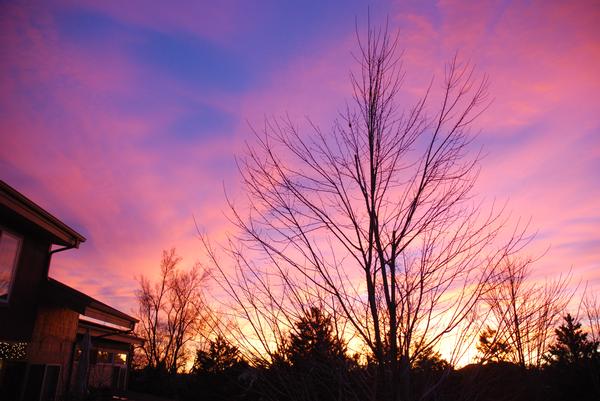I can't find my slippers, so I step outside barefoot, picking through crusty patches of snow, toes stinging as I scramble for just the right angle. The colors are swirling in all directions, and though I've seen a thousand Colorado dawns before (I have small children; I get up early), this one is different, I tell myself. I've got to get it.
Something urgent pulls me across the cold wooden deck, the light and clouds changing with each picture I take. Colorado is easy like that, or at least seems that way to me -- feeding photographers a steady, nourishing stream of grand skyscapes, wildlife, colors, textures and people to strengthen the portfolio of amateurs and professionals alike. Since I am definitely a member of the former group, I decided to reach out to a pro to find out if it was just me.
"The diversity that we have in our state is what makes us unique," says nature and wildlife photographer Don Mammoser, author of Wildflowers of Colorado Field Guide (Adventure Publications, 2007) and The Photographer's Guide to the Colorado Rockies (Countryman Press, 2008) when I contact him with my state-specific questions.
"From the prairies of the eastern half of Colorado to our national parks to the habitats of the mountains, including high tundra, to the desert canyons in extreme southwest and northwest Colorado -- other places have some of what Colorado has, but we have it all" he says.
Mammoser keeps a battered DeLorme Colorado Atlas and Gazetteer filled with notes, marks and sketches from his years of shooting. Although I've traveled a bit in my adopted state, Mammoser's miles put mine to shame.
"The San Juan Mountains certainly stand out as a favorite," he says, after first giving me the expected "there are no bad places and I love them all, even Denver" answer. "Specifically, the area around Ouray is just fantastic for scenic photography. For native Colorado wildlife, hardly any place beats Rocky Mountain National Park. There are large and small mammals, lots of birds, and much more there."
Mammoser's favorite time of year to shoot is "an easy one," he says. "Autumn. Typically the third or fourth week of September, anywhere near Telluride or Ouray, or in the central Rocky Mountains, near Aspen or Crested Butte, is just a great time to be a photographer. When we get a blue sky, combined with brilliant yellow aspen leaves and snow-capped peaks, it can be overwhelmingly gorgeous."
Of course, he adds, nothing beats "a good flower year," which comes in mid-July in most of the mountains, or a little earlier around Crested Butte.
I take a couple more shots, tilting the camera, trying to capture as much of the sky as I can, then hurry back inside.
"Daddy, what were you doing?"
My 5-year-old stands in her pajamas. I blow into my hands, stomp my feet and, before I can answer, she says, "Were you taking a picture of the sunrise again?"
I nod, take her little hand, and we walk over to the window to watch the rest of the show.
Joshua Berman is the author of "Moon Nicaragua" and "Moon Belize." He can be found on the web at JoshuaBerman.net and on Twitter at @tranquilotravel. This story originally appeared in "The Denver Post."
Our 2024 Coverage Needs You
It's Another Trump-Biden Showdown — And We Need Your Help
The Future Of Democracy Is At Stake
Our 2024 Coverage Needs You
Your Loyalty Means The World To Us
As Americans head to the polls in 2024, the very future of our country is at stake. At HuffPost, we believe that a free press is critical to creating well-informed voters. That's why our journalism is free for everyone, even though other newsrooms retreat behind expensive paywalls.
Our journalists will continue to cover the twists and turns during this historic presidential election. With your help, we'll bring you hard-hitting investigations, well-researched analysis and timely takes you can't find elsewhere. Reporting in this current political climate is a responsibility we do not take lightly, and we thank you for your support.
Contribute as little as $2 to keep our news free for all.
Can't afford to donate? Support HuffPost by creating a free account and log in while you read.
The 2024 election is heating up, and women's rights, health care, voting rights, and the very future of democracy are all at stake. Donald Trump will face Joe Biden in the most consequential vote of our time. And HuffPost will be there, covering every twist and turn. America's future hangs in the balance. Would you consider contributing to support our journalism and keep it free for all during this critical season?
HuffPost believes news should be accessible to everyone, regardless of their ability to pay for it. We rely on readers like you to help fund our work. Any contribution you can make — even as little as $2 — goes directly toward supporting the impactful journalism that we will continue to produce this year. Thank you for being part of our story.
Can't afford to donate? Support HuffPost by creating a free account and log in while you read.
It's official: Donald Trump will face Joe Biden this fall in the presidential election. As we face the most consequential presidential election of our time, HuffPost is committed to bringing you up-to-date, accurate news about the 2024 race. While other outlets have retreated behind paywalls, you can trust our news will stay free.
But we can't do it without your help. Reader funding is one of the key ways we support our newsroom. Would you consider making a donation to help fund our news during this critical time? Your contributions are vital to supporting a free press.
Contribute as little as $2 to keep our journalism free and accessible to all.
Can't afford to donate? Support HuffPost by creating a free account and log in while you read.
As Americans head to the polls in 2024, the very future of our country is at stake. At HuffPost, we believe that a free press is critical to creating well-informed voters. That's why our journalism is free for everyone, even though other newsrooms retreat behind expensive paywalls.
Our journalists will continue to cover the twists and turns during this historic presidential election. With your help, we'll bring you hard-hitting investigations, well-researched analysis and timely takes you can't find elsewhere. Reporting in this current political climate is a responsibility we do not take lightly, and we thank you for your support.
Contribute as little as $2 to keep our news free for all.
Can't afford to donate? Support HuffPost by creating a free account and log in while you read.
Dear HuffPost Reader
Thank you for your past contribution to HuffPost. We are sincerely grateful for readers like you who help us ensure that we can keep our journalism free for everyone.
The stakes are high this year, and our 2024 coverage could use continued support. Would you consider becoming a regular HuffPost contributor?
Dear HuffPost Reader
Thank you for your past contribution to HuffPost. We are sincerely grateful for readers like you who help us ensure that we can keep our journalism free for everyone.
The stakes are high this year, and our 2024 coverage could use continued support. If circumstances have changed since you last contributed, we hope you'll consider contributing to HuffPost once more.
Already contributed? Log in to hide these messages.


